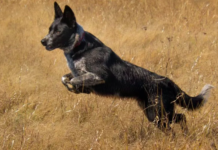Last Updated on August 31, 2023 by Fumipets
Portuguese Water Dog: The Ultimate Care Guide
The Portuguese Water Dog is a versatile and intelligent breed known for its history as a working dog in Portugal’s coastal regions. These dogs were originally bred to assist fishermen by herding fish into nets, retrieving lost gear, and even carrying messages between ships.
They are characterized by their water-resistant coat, webbed feet, and strong swimming abilities. Today, Portuguese Water Dogs make excellent companions for active families due to their friendly nature, high energy levels, and adaptability to various environments.
Portuguese Water Dog
You’ve come to the perfect place if you’re looking for a swimming or fishing buddy. Portuguese water dogs are born athletes and excellent swimmers. These dogs are ideal for persons with busy lifestyles or who want a dog to perform a lot of competitive training with since they have powerful bodies and exceptionally smart minds.
Portuguese water dogs are excellent for families since they are playful and eager to please. They have excelled as therapy and service dogs because of their high intellect and strong sensitivity.
Appearance
Although the Portuguese water dog’s genetic ancestry is unclear because it dates back approximately 800 years, poodles are thought to be the breed’s closest relative. When you see them, it all makes sense because the two breeds have a lot of traits. The coat of the Portuguese water dog can be either curly or wavy. The hair is medium to long and single-coated in both instances.
The coat comes in brown, tan, black, and white hues, with the latter being far the most uncommon. Some Portuguese water dogs have coats that are two or three colors, with black and tan being the most typical combination. Another common coloration is for either all black or all brown varieties to sport a splash of white on their chins (referred to as “milk chin”).
Another typical feature is for all-black or all-brown species to have a white spot on their chins (known as a “milk chin”).
Coats are traditionally cut in either the “lion cut” or the “retriever cut.” While the latter equally trim the coat to a length of approximately an inch all over the body, the former just trims the nose, hindquarters, and base of the tail, leaving the rest of the body long.
The Portuguese water dog sheds very little and very infrequently. The majority of the hair they do release is tangled in their curls or waves. Portuguese water dogs are well-known as a breed that is excellent for persons with allergies to hair or dander, despite the fact that no dog is really “hypoallergenic”—they all shed to some extent or another.
Their body aren’t completely square, being a little longer than they are tall, and they have webbed feet to help them swim. Male Portuguese water dogs are somewhat taller than females, standing between 20 and 23 inches.
Temperament
The Portuguese water dog is incredibly intelligent, much like its poodle relatives. They were initially developed as fishing dogs, and they were taught to herd schools of fish into nets, retrieve broken nets and equipment, and serve as messengers, bringing messages from ships to shore and ships to other ships. Portuguese water dogs could perform better with experienced dog owners because of their intelligence and desire for work.
Portuguese water dogs like learning new skills and engaging in games now that they have largely made the shift from fish to families. To gain the attention of their people and make them laugh, they frequently behave like clowns. They do really well in obedience, agility, flyball, and (of course) aquatic contests if you’re searching for a dog to compete with. Have your dog examined by a veterinarian beforehand if you’re thinking about participating in competition sports.
They are frequently friendly and excellent with kids and other animals, but they will require a lot of exercise and training. So before bringing a Portuguese water dog into the family, make sure you have the time to dedicate to these tasks!
According to Moore, the breed can occasionally be wary of strangers, but with the right socialization, they become open to having strangers pet them.

The intelligent Portuguese water dogs, like the poodle, are easily bored if you don’t keep them engaged. They are an extremely active dog who needs at least an hour of exercise every day. Another reason why practicing for competitions is a fantastic hobby for kids is because of this.
However you go about it, it’s important to keep your dog healthy and content because they have the propensity to chew when they’re bored or upset. Your belongings will be destroyed if you overly neglect your Portuguese water dog at home or if you don’t give him enough exercise.
Portuguese water dogs will require extensive obedience training, just like any other highly clever dog. Not only will it keep them mentally active, but it will also reduce some of their undesirable tendencies, such as the breed’s propensity to leap up to greet people or their infamous reputation as counter surfers.
In homes with cats and other dogs, Portuguese water dogs adapt quite well. They make a wonderful choice for families with other small animals as well because they have a low prey drive. Although they like spending time with kids, they might be a touch too boisterous for very young ones.
Portuguese water dogs are also excellent at therapy or service work, and some of them go through training to become support dogs for the deaf or the hard of hearing. They quickly pick up on basic commands like barking when the phone rings or someone knocks on the door.
Living Needs
The two most important elements for housing a Portuguese water dog are mental and physical stimulation. They can easily adjust to apartment life as long as you take them for a daily run or game of fetch. If your home has a sizable, gated backyard? Better still. And if there is a lake or pool nearby? Holy mackerel, they’re in heaven.
Have your dog examined by a veterinarian beforehand if you’re thinking about participating in competitive sports.
The dogs are usually safe to keep off a leash or in the front yard with supervision since they have a very low prey drive and are unlikely to run off after a squirrel. To prevent children from getting bored, it’s a fantastic idea to provide a range of toys. Giving them a selection of toys and using some gentle positive reinforcement training can help you rapidly educate them on which items are OK for chewing and which ones are not.
Care
Yes, they will be a challenge. Fun Portuguese water dog information: Their hair keeps growing indefinitely. Have you seen the photos of the Australian sheep that strayed out for seven years before returning looking like a gigantic cotton ball? Delgado warns that if you don’t groom your Portuguese water dog every six to eight weeks, that’s what you’ll get.
To prevent that wavy (or curly) hair from matting up and sticking frantically to every twig and leaf it encounters, in addition to cuts, you’ll brush them every other day.
Additionally, you should give your dog a short rinse off straight away after letting them swim in a chlorinated pool, a saltwater body, or a lake that has algae in it to ensure that their hair doesn’t retain odors.

Health
Portuguese water dogs are susceptible to hip dysplasia like other breeds. Delgado advises owners to wait until their dogs are 18 months or 2 years old to spay or neuter them in the hopes of preventing hip issues.
Spaying or neutering puppies in the first year may prevent joint damage and other illnesses in some breeds, according to some study. Before a Portuguese water dog’s growth plates close, spaying and neutering around the six-month mark can encourage a growth spurt, which can lead to joint problems.
Portuguese water dogs haven’t been a part of research on delayed neutering, though. In reality, a 2020 research indicated that the majority of breeds may be neutered “without referral to a particular age.”
There is no simple solution, therefore pet owners should discuss the advantages and disadvantages of neutering their pet with their veterinarian in connection to orthopedic issues, cancer, or other issues like urine incontinence.
The recessive gene that causes night blindness and can cause complete blindness in Portuguese water dogs can also induce cataracts and progressive retinal atrophy. To determine if your dog is a carrier of the gene or not, your veterinarian can do a quick DNA test.
Another recessive gene that, while exceedingly rare, can be deadly is juvenile dilated cardiomyopathy, so you might want to have your veterinarian test for that.
The Portuguese Water Dog Association of America, the official breed group, recommends that new puppy parents have their veterinarians do all the testing and screenings.
Bo and Sunny, the family dogs of President Barack Obama throughout his two terms in office, are arguably the most well-known Portuguese water dogs in the United States.
History
According to the Portuguese Water Dog Club of America, a monk who witnessed a sailor being pulled from the water by a dog with a “black coat, the hair long and rough, cut to the first rib and with a tail tuft” in 1297 is the first person to have written about a dog that resembles our modern Portuguese water dog.
On the shores of Portugal and Spain, dogs have flourished for generations. There are (perhaps fictitious) legends of the Spanish Armada using dogs to communicate between ships. As the number of fishermen decreased and their vocations were gradually replaced by technology throughout the 19th century, the dog’s population rapidly decreased until it was almost extinct by the 1930s.
Vasco Bensaude, a Portuguese shipping tycoon, turned the tide in the 1930s by actively searching out the dogs in fishing communities with the goal of reviving the breed.
The first dog, a progeny of Bensaude’s kennels, was brought to the United States in the 1960s by two Americans called Deyanne and Herbert Miller, Jr. The Portuguese Water Dog Club of America was established in 1972, and the American Kennel Club recognized the breed in 1981.
Q&A about the Portuguese Water Dog:
1. What is the origin of the Portuguese Water Dog?
The Portuguese Water Dog, or “Cão de Água Português,” has a history dating back to the coastal regions of Portugal. They were used by fishermen to perform tasks such as herding fish, retrieving objects from water, and guarding boats.
2. What are the distinctive features of the breed’s coat?
Portuguese Water Dogs have a dense, curly or wavy coat that is both water-resistant and hypoallergenic. Their coat serves to protect them while working in the water.
3. How is the temperament of the Portuguese Water Dog?
These dogs are known for their intelligence, loyalty, and friendly nature. They tend to form strong bonds with their families and are usually good with children and other pets. They thrive on companionship and enjoy being active.
4. What type of living environment suits the breed?
Portuguese Water Dogs are adaptable and can live in various environments, including apartments or houses with yards. However, due to their high energy levels, they require regular exercise and mental stimulation.
5. How much exercise does a Portuguese Water Dog need?
This breed is highly active and requires daily exercise to maintain their physical and mental well-being. Activities like swimming, playing fetch, and long walks are beneficial for them.
https://www.youtube.com/watch?v=ekZq6y9GBa0


















